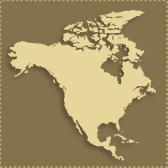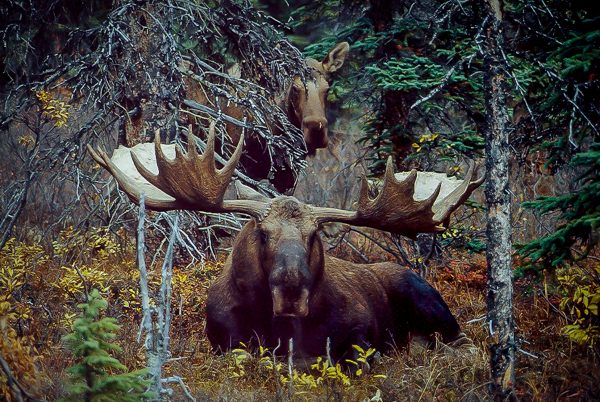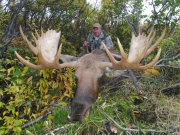Adventure Planner
Moose Hunting | Varieties and Distribution of Huntable Moose Subspecies
Moose can easily weigh over 1,500 pounds and stand seven foot at the shoulder. A large bull’s antlers can weigh over 90 pounds. Atchesons definitely know moose hunting and have fielded thousands of moose hunters over the last 6 decades, and we do know where to send you to get your moose! Our clients have moose in the top ten of all-time of all moose species! Henry S. Budney’s trophy bull has a spread of 72 inches; 20 inches across each palm, and 31 points all total. Larry Hammer’s giant moose is over 73 inches wide, carrying 35 points. Michael E. Laub hunted northern British Columbia, where he took a bull with a 63-inch spread, 23-inch palm, and 31 antler points. At last glance, this bull was the current Canadian world record moose.
Alaska-Yukon Moose
The Alaska-Yukon moose is the largest antlered animal in the world. The Boone & Crockett Club and Safari Club International (SCI) consider the distribution of the Alaskan-Yukon subspecies territory to include all of Alaska, the Yukon Territory, and all of the Northwest Territories. Until you see one of these gigantic beasts on the hoof, it is hard to imagine just how large they are. They are even more impressive lying on the ground.
Alaska has always been a top choice of trophy moose hunters, there are many great outfitters and areas! From the south slopes of the Brooks Range to Bristol Bay to the Wrangell Mountains, we have reserved the best hunting for you!
The Brooks Range has some spectacular bull moose. Due to the remoteness, these moose may live their entire lives never seeing a human. Moose hunting is conducted on the south side of the Brooks Range. They are hunted from the typical fly-out spike camp, river boat, or by horseback. The Brooks Range Alaska Barren Ground caribou herd is one of the largest in the world and may occupy some regions in great abundance, and it might be a good idea to have a Grizzly tag as well, if the hunt allows for taking one on a chance encounter. This is the only Alaska region offering the classic moose, caribou, and Grizzly combo, with limited openings!
Western Alaska is loaded with prime moose hunting. This part of Alaska is gentle for the most part, with rolling hills from 500 to 2,500 feet high. The higher reaches of these hills are ideal habitat for Brown and Grizzly Bear, plus many Black Bear. The lower lying areas contain birch, spruce, willow, and alder, made to order for growing big moose. The world’s largest salmon runs fill these regions streams, drawing big Grizzly, Brown, and Black Bears to feed on the multitudes of fish. A perfect mixed bag hunt destination, fly-out spike camps are usually a requirement when combining multiple species on a single hunt.
The Alaskan Peninsula has always been famous for big moose, due largely in part to the Alaska Game Department rigidly regulating moose hunting, which has led to high trophy quality. Hunters usually fly to a base camp a day before the hunt is to start. The outfitter often has been scouting and may already have a very large bull moose located. Moose are rutting at this time, so the hunting is excellent. Because of the 10-day season (September 1st – 20th), openings are limited and we recommend booking early, and don’t forget the fishing pole!
Central/Eastern Alaska: A common feature of the moose in this region of Alaska are beautiful antlers and magnificent, multi-pointed palmation. A world record Alaskan-Yukon Moose was taken here a few years back. Late August/September is prime time in this area for a moose hunt. Grizzly or Brown Bear can be combined late August to September 25th, and Dall Sheep or even Mountain Goat can be included in some areas. This country lends itself to using horses! Hunting moose from horseback is far easier than hunting on foot, but the real beauty is watching a horse carry that half-ton of meat back to camp.
Yukon Territory: As their name implies, the Canadian Yukon is home to the largest subspecies of moose as well. Areas to the east of Whitehorse in the central Yukon contain the bulk of the truly good moose hunting found in this part of Canada. All the terrain here is fairly mountainous and often heavily forested. Hunters utilize a number of hunting styles in this area, such as horseback in the higher basins, or by boat on large rivers and numerous lakes. Trophy quality moose become feasible in late August and remains very good through freeze-up, which usually occurs in mid-October. Spot-and-stalk is normally used, and the art of calling moose is practiced with a high degree of success as well. Moose hunts are generally 10 to 12 days in length, with multiple species including Dall/Stone/Fannin Sheep, Grizzly and Black Bear, and Mountain Caribou hunts running 14 to 16 days. Also, make sure you’re “saddle ready” if you book a horseback hunt.
(Western and Eastern) Canadian Moose
We offer Western Canadian moose by horseback, progressive travel tent camps, and by boat on rivers and lakes. Northern British Columbia produces bulls carrying a horn spread of 50 to 60 inches or more, which is not a bad bull at all! Combo with Mountain Goat, Mountain Caribou, Elk, and Stone Sheep. In Alberta, Canadian Moose hunts run from September to November 30th. Combo with Whitetail and Mule Deer, Black Bear, or even the Giant Woodland Bison.
Eastern Canadian Moose are hunted in Manitoba and Newfoundland. Productive Manitoba combos can include Central Barren Ground Caribou, Black Bear, and even Muskox in nearby Nunavut. In Newfoundland, you can hunt Black Bear, and limited Woodland Caribou are available. The popular and productive “moose calling” rut season has a wide range and runs mid-September to late October. Bulls sport antlers of 45 to 60 inches in width. Lodging varies from mountain tent camps to rustic cabins. What is best for your party? A boat hunt, horseback, vehicle, or ATV? All have high success/opportunity rates.
Shiras Moose
There is a difference of opinion on the distribution of Shiras moose, but it is generally accepted that the western states and southern British Columbia contain this species. Within the states, it is very difficult to draw. However, we have access to landowner (no draw) Shiras Moose hunts in Utah, and a limited number of no drawing permits are also available for Shiras Moose in British Columbia, where most bulls range from 35 to 45 inches and hunts have historically been very successful. In the southern third of British Columbia, Shiras moose can be combined with Mule Deer, Mountain Goat, and Black Bear. Most hunting here is done out of a lodge or cabin, and then using horses, on foot, and vehicles for day trips.




